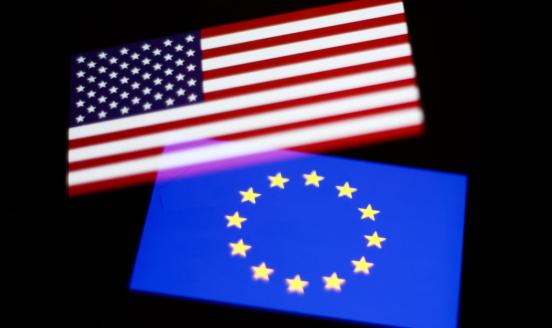An update: Vaccination in the EU
Progress has been made, but more progress is needed.

The slow pace of COVID-19 vaccinations in the EU has been a cause of great concern, and with good reason. It is causing loss of life and well-being, as well as harm to the EU economy.
When we say that the pace of vaccination is slow, it is natural to ask: compared to what? The figure below depicts the number of COVID-19 cases per day per million of population and the current rate of vaccinations per day for a broad selection of OECD countries. Japan, Australia and South Korea are vaccinating at a very slow pace, but this is arguably of little concern since they have had very few cases to date. By contrast, Israel, the USA and the United Kingdom have had a very high number of cases relative to population, but they are vaccinating at a brisk pace. The sampling of EU countries shown (France, Germany, Italy, Poland, Spain, Sweden) have high numbers of cases relative to population, but a slow rate of vaccination – a clearly unfortunate combination.
The details are complex, but the basic underlying problem is not difficult to understand. Large-scale orders for BioNTech Pfizer and Moderna vaccines (the first vaccines approved for use in the EU) appear to have been placed several months later than in the United States and the United Kingdom – countries that, like the EU, are large and prosperous, and that like the EU have experienced large numbers of COVID-19 cases. There is no great mystery to the delay: Late placement of orders led to late deliveries.
In the midst of hand-wringing over current state of affairs in the EU, it is easy to miss the fact that things are gradually improving. The pace of vaccination is picking up as production ramps up. More vaccines are demonstrating safety and efficacy, meaning not only that more can be produced, but also that a wider range in the capabilities of vaccines has become available, and with it more ability to respond to different public health needs.
On the negative side of the balance sheet, variants have emerged in the UK, South Africa, Brazil and the United States that are more contagious and possibly more dangerous than the variants identified up until now. This bad news is mitigated, however, by the fact that most of the vaccines that have been approved appear to be reasonably effective against most of the variants.
The pace of vaccination
The pace of vaccination has been accelerating for some time. Shown here is a smoothed average of the number of individuals vaccinated per day per million of population of the country depicted.
The pace of vaccination depends primarily on three things: (1) the availability of vaccine, (2) distribution of vaccine to EU member states together with administration in the member states, and (3) willingness of individuals to be vaccinated. Given that the allocation of authorised vaccines in the EU is based on population, the degree to which the pace of vaccination in the four largest economies in the EU tracks one another strongly suggests that the first of these, supply, is the binding constraint at present. To put some numbers on this, consider that the smoothed average of the fraction of the population vaccinated in France, Germany, Italy and Spain on 4 March was 0.20%, 0.22%, 0.23% and 0.26%, respectively – they are in a relatively tight range.
A second key point, easily missed in the graph, is that the pace of vaccination in the four largest EU member states has picked up considerably in recent weeks. The pace in the UK and in the USA was three or four times faster than that of the EU just a few weeks ago. Today we are rapidly approaching a point at which the pace in the UK and the USA is ‘only’ twice as fast as the EU.
An easier way to visualise this is to consider the number of days required to vaccinate 1% of the population. By this measure (which is essentially the inverse of the numbers in the previous graph), it becomes clear that the member states that represent the four largest economies in the EU are doing about twice as well as they were a few weeks ago, while the UK and the USA seem to have stabilised more or less at a steady pace.
The EU was arguably about three months behind the UK in placing orders for the AstraZeneca vaccine. If the supply-limited pace of vaccination in the EU is also about three months behind the UK, as appears to be the case, then one can reasonably hope that the pace of vaccination will be comparable to that of the UK and the USA one to two months hence.
Once again, inadequate supplies are a crucial factor, but they are not the only factor – not all supplies are being used efficiently. In Germany, for instance, 8.7 million vaccine doses had been administered as of 12 March 2021, representing just 70% of the 12.5 million doses that had been delivered. Some press sources suggest that reluctance to take the vaccine is a major factor, but the prohibition on the use of the AstraZeneca vaccine to individuals older than 65 in Germany (lifted at the beginning of March) surely was also a significant factor, and normal supply chain delays probably also play a role.
What goal to reach when?
EU policymakers are increasingly speaking of reaching 70% vaccinated at some point during the autumn of 2021. If the pace of vaccination continues to pick up, and if there are no unexpected hiccups, this might very well be achievable.
Does this represent the point at which the EU enjoys herd immunity? Not necessarily. Herd immunity depends on a whole host of factors, including the number of individuals who are immune to relevant variants of COVID-19 because they either have been vaccinated or infected. The threshold at which herd immunity is reached is not a single, immutable number, but is heavily dependent on the reproduction number (R), which is itself dependent on the contagious variants that appear and on non-pharmaceutical interventions (NPIs) such as distancing and masks. In other words, it does not appear to be possible today to predict the exact percentage infected plus vaccinated that is needed to achieve herd immunity.
The aim instead should be to vaccinate at least 70% because it is a realistically achievable goal that should serve to greatly reduce the number of individuals who die from the pandemic, the number who suffer long term debilitating effects, and the risk of overloading hospitals in general and ICUs in particular.
Expected deliveries of vaccines
A more pressing question is, when is the shortage of authorised vaccines likely to be ameliorated?
In preparation for a summit between the national government and the Bundesländer on 1 February, the German government prepared a summary of expected vaccine deliveries, as shown below. This provides concrete information on expected delivery schedules, which up to now has been hard to come by. If all goes as planned, the number of doses expected to be available by the end of the third quarter exceeds that required to vaccinate the entire German population. Given that the vaccines have been centrally ordered by the European Commission’s Emergency Support Instrument (ESI) on behalf of the member states, and that doses are allocated to the member states on the basis of population, the percentage of the population that could potentially be vaccinated should be roughly the same in each of the member states[1]. In other words, if all goes as planned, there should be a substantial glut of authorised vaccine in the EU by the end of the year.
[1] Some member states apparently chose not to receive their allocations of BioNTech Pfizer vaccine, and subsequently had second thoughts, so there are some variations. Nonetheless, the German data provide a reasonable picture of what can be expected for the EU as a whole.
This was the expected status as of 1 February, assuming no unexpected delays; however, there have been delays, and further delays cannot be ruled out. These are brand new vaccines, and several rely on novel manufacturing techniques. Going forward, prompt and proactive management, flexibility and contingency planning will surely be needed. It is incumbent on the Commission (which made the vaccine purchases) to effectively manage the supply chain.
[2] The numbers shown here reflect conservative assumptions. Even if a delivery was listed in the table provided by the German government, it is not included here unless the order is known to have been firmly placed. Vaccines that are not yet authorised are not included. In consequence, doses of the Curevax and Sanofi vaccines are not shown, and the optional doses of Moderna vaccine are not shown. For similar reasons, even though the Russian Sputnik V vaccine has applied to the EMA for authorisation, it does not appear here. In calculating the fraction of the German population that could potentially be immunised, it is assumed that two doses are required for all vaccines other than the Johnson & Johnson.
Progress in research on vaccines
The emergence of new, more contagious variants of the virus that causes COVID-19 was not unexpected, but the number and speed of dangerous variants is worrisome. The worrisome variants are more contagious than the prevalent COVID-19 variants, and some may also be more deadly. The UK variant appears to be more contagious among schoolchildren than the familiar variants.
A sampling of research results serves to illustrate that despite this growing threat, most of the authorised vaccines are achieving reasonably good results against most of the variants. Since all of the authorised vaccines achieved good results in Phase 3 trials in terms of safety (otherwise they would not have been authorised), we do not discuss safety further here.
The BioNTech Pfizer vaccine achieved 95% efficacy in Phase 3 trials. Actual results in use in Israel support efficacy in the neighbourhood of 90%. Significantly, laboratory tests suggest good efficacy against all of the main known variants of the SARS-CoV-2 virus.
While results from the Phase 3 trial of AstraZeneca were puzzling, at the recommended dosage the efficacy was 62%, which is in line with the 60% figure that the EMA published. New results based on real world observation of more than a million vaccinated individuals in Scotland show the AstraZeneca vaccine to have been 94% effective 28 to 34 days after a first dose, versus 85% for the BioNTech Pfizer vaccine. However, we caution that the results are not comparable with those of the Phase 3 trial because (1) the standard of effectiveness was hospitalisation, not infection as measured by a PCR test; (2) the comparison was after a single dose; and (3) the results appear in a pre-print that is convincing, but that has not been peer-reviewed. Still, the result is important to the extent that it suggests good effectiveness in preventing serious outcomes for individuals infected by the UK variant of the SARS-CoV-2 virus. Another result (not yet peer reviewed), however, is troubling – based on a small double-blind study, the AstraZeneca vaccine appears to have only limited effect (22% efficacy) in preventing mild to moderate infection by the South African variant. South Africa has suspended use of the vaccine; however, the WHO continues to recommend it, arguing that it is possible that it is effective against severe infection of the South African variant, and that developing countries typically will not have better alternatives for now. Finally, as of 15 March, many EU countries had put on hold the use of the AstraZeneca vaccine until reports that the vaccine might possibly cause harmful blood clots have been resolved.
The Moderna vaccine continues to appear to be safe and effective, but it has played only a small role in the EU to date because supplies have been limited.
The Johnson & Johnson vaccine was authorised for use in the EU on 12 March 2021. It has the advantage that a single dose provides adequate protection – an advantage for all countries, but an especially important advantage for developing countries. In authorising the vaccine for use in the USA, the US FDA rated its efficacy as 72% percent for the variants active in the US, and 64% for those active in South Africa (which is 7% higher than the company had claimed).
Many Western experts were initially sceptical of the Russian Sputnik V vaccine, but published peer-reviewed results are quite respectable. The vaccine demonstrated efficacy of 92%, which is not significantly different from the BioNTech Pfizer and the Moderna vaccines. The EMA is evaluating the vaccine.
Is cautious optimism warranted?
Taking all of this together, there are grounds for cautious optimism as we look to likely developments over the next two or three quarters. Even so, getting a large proportion of the EU population represents a substantial challenge, and many risks remain.
Policymakers face enormous challenges. Restriction fatigue is increasingly visible. Public pressure for relief from pandemic restrictions has grown to the point of being practically irresistible. This is, however, no reason to totally let down our guard. Selective, highly targeted easing of restrictions may be possible, but a widespread easing of restrictions risks a new wave of infection from the newer and more contagious variants at a time when only a small percentage of the EU population has been vaccinated or infected. Public support for continued public health measures consequently continues to be essential over the coming months.
For the research community together with pharmaceutical companies, a huge number of questions remain unanswered or only partially answered. Which variants are expanding their footprint in the EU, and where? How effective is each of the known vaccines against each of the variants? What is the risk that those who were already infected with COVID-19 might be re-infected with one of the new variants? Which vaccines could safely be administered to children younger than 16 years of age, and at what doses? How vulnerable are children to (possibly asymptomatic) infection, and how contagious are they when infected? What are the consequences if a second dose of a vaccine is delayed? What are the consequences if an individual who has received one vaccine is subsequently vaccinated with a different vaccine? And a question that is crucial for any reopening of travel: For those who have been vaccinated, to what degree is there still a risk that they could carry enough of a viral load to be contagious? Research is under way or has been conducted on most of these questions, but in most cases the completed results are not definitive, and in quite a few cases new results contradict earlier assumptions.
Finally, while the pharmaceutical industry deserves enormous praise for delivering so many safe and effective vaccines so quickly, the challenge now is to ramp up production so as to meet demand in the EU and worldwide.
Recommended citation:
Marcus, J. Scott and N. Poitiers (2021) ‘An update: Vaccination in the EU’, Bruegel Blog, 17 March



